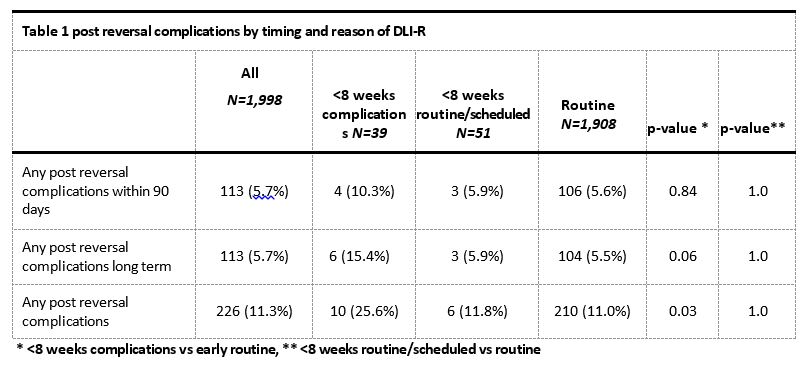P113 Defining the Safety of Early Ileostomy Closure After IPAA
Clancy, C.(1);Connelly, T.(1);Jia, X.(1);Lipman, J.(1);Lightner, A.(1);Hull, T.(1);Steele, S.(1);HolubarMD- MS, S.(1);
(1)Cleveland Clinic, Department of Colon & Rectal Surgery, Cleveland, United States;
Background
Patients undergoing ileal pouch-anal anastomosis commonly wish to have their ileostomy reversed as quickly as possible. The safety of ileostomy reversal (DLI-R) within 8 weeks of surgery has not been established. Our hypothesis is early closure before 8 weeks is associated with negative outcomes.
Methods
Patients who underwent primary IPAA with DLI from 2000 – 2021 from our Pouch Registry were retrospectively reviewed and stratified into groups based on timing of ileostomy closure: very early, routine (< 8 weeks, 56-116 days, respectively). Reasons for early closure were reported. Our primary outcome was overall complication rates according to timing of closure. Univariate analysis was used to compare categorical variables between groups.
Results
2,000 patients underwent DLI-R following IPAA at a very early or routine timepoint: 3-stage 62%, 2-stage 38%; median age 39.2. DLI-R was performed very early in 92 patients and early routine in 1,908. Median time to closure in the very early group is 49 days and in the early routine group was 93 days. There were no differences between the two groups in age or BMI, but the very early group had a higher proportion of females (62% vs 41.5% p<0.001) and a higher proportion of patients with ASA 1-2 (65.2% vs 51.9% p<0.02). Reasons for DLI-R in the very early group were stoma related problems in 39 patients (43.3%) with scheduled closure in 51 patients (56.7%). Complications following DLI-R occurred in 11.3% of patients overall. The complication rate in the very early group was 17.4% compared to 11% in the routine group (p=0.09) and are shown in Table 1. When the patients in the very early group were stratified according to reason for DLI-R those reversed early for stoma related problems had a complication rate of 25.6% compared to 11% in the early routine group (p=0.03). Patients undergoing scheduled DLI-R in the very early group did not have higher complication rates than the routine group (11.8% vs 11% respectively, p=1.0).
Conclusion
DLI-R at <8 weeks following IPAA does not appear to be associated with a statistically higher rate of complications compared to closure in a standard time frame. However, when patients were reversed early due to complications associated with their stoma they had worse outcomes.



